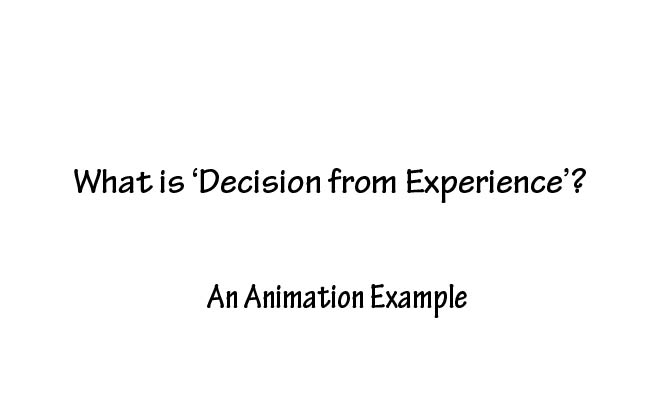 |
 |
 |
|
In this example, information about the probability that the rabbit would pop out of each hole is not explicitly described to you. You obtain knowledge about probability through experience interacting with the experiment. This type of choices is often referred to as ‘decision from experience’. In contrast, when information about options are fully described to you, this type of choice is referred to as ‘decision from description’. Do people behave differently in description-based decision from experience-based decision? A growing body of research suggests this is indeed the case. It was first reported by Hertwig et al. (2004, Psychological Science) and was referred to as the description-experience gap. Specifically, the gap is about differences in how people weight information about probabilities: - When making risky decisions, people overweight small-probability outcomes when it is explicitly described to the subjects (Kahneman & Tversky, 1979). - When probability is learned through sampling experience, people tend to underweight small-probability outcomes (see Hertwig & Erev, 2009 for a review).
We are interested in what contributes to the Description-Experience gap. In particular, we ask whether the interaction between experience and pairing of probabilities with outcomes contributes to the gap. Below is the design of the two experiments that aimed to address this question. |
Tasks |

|
Before the experiment, subjects are told they are engaged in a behavioral decision-making experiment. They are going to play many decks of cards. For each deck separately, the subjects went through two phases, sampling and decision-making respectively. 1. Sampling phase
Prior to sampling a deck of card, subjects were presented with the deck number and its two possible monetary outcomes on the screen. The subjects initiated the sampling phase by pressing a button. On each trial, the subjects were instructed that a card would be drawn randomly from 100 cards, and that the monetary outcome associated with the drawn card would be revealed. The subjects were also instructed that the sampled card would be put back to the deck before the next trial began (sampling with replacement). Sample size was determined randomly and ranged from 35 to 45 trials. The subjects were neither told the number of trials nor its range. This was designed to discourage subjects from calculating the frequency of reward through counting. 2. Decision-making phase After the subjects learned the information of this deck of cards, they were instructed to choose between the lottery option and a sure outcome option. The subjects need to point to the box and make the box filled to indicate their choice. You can see there were 6 choices in each menu and subjects have to finish all 6 choices, referred to as a “round” of choices.
This an adaptive lottery choice task such that we could obtain the certainty equivalent (CE) of each lottery. 3. Results In two experiments, subjects had to first sample from probability distributions. In Experiment 1, subjects learned probability distributions on events in the sampling phase. The events were then arbitrarily paired with different monetary outcomes to construct lotteries for choice during the decision-making phase. In Experiment 2, subjects directly sampled from lotteries – probability distributions on monetary outcomes in the sampling phase. In contrast to previous findings in experienced-based decisions, we found that subjects in both experiments consistently overweight small probabilities. These results were in sharp contrast to the underweighting of rare events reported in previous studies on decision from experience.
|
| Back to Top |